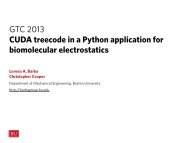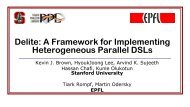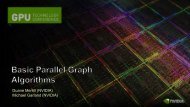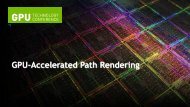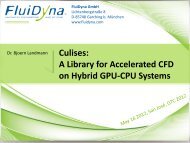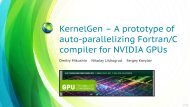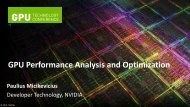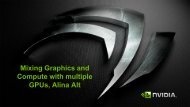Sailfish: Lattice Boltzmann Fluid Simulations with GPUs and Python
Sailfish: Lattice Boltzmann Fluid Simulations with GPUs and Python
Sailfish: Lattice Boltzmann Fluid Simulations with GPUs and Python
- No tags were found...
Create successful ePaper yourself
Turn your PDF publications into a flip-book with our unique Google optimized e-Paper software.
<strong>Sailfish</strong>: <strong>Lattice</strong> <strong>Boltzmann</strong> <strong>Fluid</strong> <strong>Simulations</strong> <strong>with</strong> <strong>GPUs</strong> <strong>and</strong> <strong>Python</strong>Micha̷l JanuszewskiInstitute of PhysicsUniversity of Silesia in Katowice, Pol<strong>and</strong>GoogleGTC 2012M. Januszewski (IoP, US) <strong>Sailfish</strong>: LBM <strong>with</strong> <strong>GPUs</strong> <strong>and</strong> <strong>Python</strong> GTC 2012 1 / 26
My adventure <strong>with</strong> Computational <strong>Fluid</strong> Dynamics on <strong>GPUs</strong>Let’s go back to 2009...Was working <strong>with</strong> stochastic differental equations on <strong>GPUs</strong> (google sdepy if you’reinterested).credit: ”Piled Higher <strong>and</strong> Deeper” by Jorge Cham, www.phdcomics.comSome previous experience <strong>with</strong> Smoothed Particle Hydrodynamics on CPUs.No prior knowledge of the lattice <strong>Boltzmann</strong> method.Started <strong>with</strong> a simple implementation in C <strong>and</strong> quickly rewrote it in <strong>Python</strong> & CUDACṂ. Januszewski (IoP, US) <strong>Sailfish</strong>: LBM <strong>with</strong> <strong>GPUs</strong> <strong>and</strong> <strong>Python</strong> GTC 2012 2 / 26
My adventure <strong>with</strong> Computational <strong>Fluid</strong> Dynamics on <strong>GPUs</strong>Let’s go back to 2009...Was working <strong>with</strong> stochastic differental equations on <strong>GPUs</strong> (google sdepy if you’reinterested).credit: ”Piled Higher <strong>and</strong> Deeper” by Jorge Cham, www.phdcomics.comSome previous experience <strong>with</strong> Smoothed Particle Hydrodynamics on CPUs.No prior knowledge of the lattice <strong>Boltzmann</strong> method.Started <strong>with</strong> a simple implementation in C <strong>and</strong> quickly rewrote it in <strong>Python</strong> & CUDACṂ. Januszewski (IoP, US) <strong>Sailfish</strong>: LBM <strong>with</strong> <strong>GPUs</strong> <strong>and</strong> <strong>Python</strong> GTC 2012 2 / 26
My adventure <strong>with</strong> Computational <strong>Fluid</strong> Dynamics on <strong>GPUs</strong>Let’s go back to 2009...Was working <strong>with</strong> stochastic differental equations on <strong>GPUs</strong> (google sdepy if you’reinterested).credit: ”Piled Higher <strong>and</strong> Deeper” by Jorge Cham, www.phdcomics.comSome previous experience <strong>with</strong> Smoothed Particle Hydrodynamics on CPUs.No prior knowledge of the lattice <strong>Boltzmann</strong> method.Started <strong>with</strong> a simple implementation in C <strong>and</strong> quickly rewrote it in <strong>Python</strong> & CUDACṂ. Januszewski (IoP, US) <strong>Sailfish</strong>: LBM <strong>with</strong> <strong>GPUs</strong> <strong>and</strong> <strong>Python</strong> GTC 2012 2 / 26
My adventure <strong>with</strong> Computational <strong>Fluid</strong> Dynamics on <strong>GPUs</strong>Let’s go back to 2009...Was working <strong>with</strong> stochastic differental equations on <strong>GPUs</strong> (google sdepy if you’reinterested).credit: ”Piled Higher <strong>and</strong> Deeper” by Jorge Cham, www.phdcomics.comSome previous experience <strong>with</strong> Smoothed Particle Hydrodynamics on CPUs.No prior knowledge of the lattice <strong>Boltzmann</strong> method.Started <strong>with</strong> a simple implementation in C <strong>and</strong> quickly rewrote it in <strong>Python</strong> & CUDACṂ. Januszewski (IoP, US) <strong>Sailfish</strong>: LBM <strong>with</strong> <strong>GPUs</strong> <strong>and</strong> <strong>Python</strong> GTC 2012 2 / 26
This talkWhy did I do that, how it worked out <strong>and</strong> can you dosomething similar?... <strong>with</strong> some technical details ...M. Januszewski (IoP, US) <strong>Sailfish</strong>: LBM <strong>with</strong> <strong>GPUs</strong> <strong>and</strong> <strong>Python</strong> GTC 2012 3 / 26
<strong>Fluid</strong> simulation1 Macroscopic scale: continuum, velocity (⃗v), pressure (p),Navier-Stokes equation:( )∂⃗vρ∂t + ⃗v · ∇⃗v = −∇p + µ∇ 2 ⃗v + ⃗ f2 Mesoscopic scale: particle ensemble, the lattice <strong>Boltzmann</strong>method.∂f∂t + ∂f∂⃗x · ⃗p m + ∂f∂⃗p · ⃗F = ∂f∂t ∣ coll3 Microscopic scale: invidual molecules <strong>and</strong> atoms, molecular dynamics.M. Januszewski (IoP, US) <strong>Sailfish</strong>: LBM <strong>with</strong> <strong>GPUs</strong> <strong>and</strong> <strong>Python</strong> GTC 2012 4 / 26
<strong>Fluid</strong> simulation1 Macroscopic scale: continuum, velocity (⃗v), pressure (p),Navier-Stokes equation:( )∂⃗vρ∂t + ⃗v · ∇⃗v = −∇p + µ∇ 2 ⃗v + ⃗ f2 Mesoscopic scale: particle ensemble, the lattice <strong>Boltzmann</strong>method.∂f∂t + ∂f∂⃗x · ⃗p m + ∂f∂⃗p · ⃗F = ∂f∂t ∣ coll3 Microscopic scale: invidual molecules <strong>and</strong> atoms, molecular dynamics.M. Januszewski (IoP, US) <strong>Sailfish</strong>: LBM <strong>with</strong> <strong>GPUs</strong> <strong>and</strong> <strong>Python</strong> GTC 2012 4 / 26
<strong>Lattice</strong> <strong>Boltzmann</strong>: the algorithm1 Collision:f ⋆ α(⃗x i , t) = f α (⃗x i , t) − f α(⃗x i , t) − f (eq)α (ρ i ,⃗v i )τ2 Streaming:f α (⃗x i + ⃗c α , t + 1) = f ⋆ α(⃗x i , t)M. Januszewski (IoP, US) <strong>Sailfish</strong>: LBM <strong>with</strong> <strong>GPUs</strong> <strong>and</strong> <strong>Python</strong> GTC 2012 6 / 26
<strong>Lattice</strong> <strong>Boltzmann</strong>: the algorithm1 Collision:f ⋆ α(⃗x i , t) = f α (⃗x i , t) − f α(⃗x i , t) − f (eq)α (ρ i ,⃗v i )τ2 Streaming:f α (⃗x i + ⃗c α , t + 1) = f ⋆ α(⃗x i , t)M. Januszewski (IoP, US) <strong>Sailfish</strong>: LBM <strong>with</strong> <strong>GPUs</strong> <strong>and</strong> <strong>Python</strong> GTC 2012 6 / 26
<strong>Lattice</strong> <strong>Boltzmann</strong>: the algorithm1 Collision:f ⋆ α(⃗x i , t) = f α (⃗x i , t) − f α(⃗x i , t) − f (eq)α (ρ i ,⃗v i )τ2 Streaming:f α (⃗x i + ⃗c α , t + 1) = f ⋆ α(⃗x i , t)M. Januszewski (IoP, US) <strong>Sailfish</strong>: LBM <strong>with</strong> <strong>GPUs</strong> <strong>and</strong> <strong>Python</strong> GTC 2012 6 / 26
Why lattice <strong>Boltzmann</strong>?Applicable for low Mach number flows.Good for flows in complex domains (e.g. porousmaterials).Extremely well parallelizable (nearest-neighbourinteractions).Easy to implement.Image credit: EXA Corp.M. Januszewski (IoP, US) <strong>Sailfish</strong>: LBM <strong>with</strong> <strong>GPUs</strong> <strong>and</strong> <strong>Python</strong> GTC 2012 7 / 26
<strong>Lattice</strong> <strong>Boltzmann</strong>: History600500400papers30020010001990 1995 2000 2005 2010yearFigure: Papers <strong>with</strong> ”lattice <strong>Boltzmann</strong>” in the title (source: Scopus)M. Januszewski (IoP, US) <strong>Sailfish</strong>: LBM <strong>with</strong> <strong>GPUs</strong> <strong>and</strong> <strong>Python</strong> GTC 2012 8 / 26
What is <strong>Sailfish</strong>?Image credit: Wikimediahttp://sailfish.us.edu.plGPU-based implementation of the lattice <strong>Boltzmann</strong> method.Open source (LGPL v3).Implemented using <strong>Python</strong> <strong>and</strong> CUDA C / OpenCL.Written from scratch.Under development for approximately 3 years.M. Januszewski (IoP, US) <strong>Sailfish</strong>: LBM <strong>with</strong> <strong>GPUs</strong> <strong>and</strong> <strong>Python</strong> GTC 2012 9 / 26
Why <strong>Python</strong>?✓ Easy to underst<strong>and</strong>.✓ Very expressive (get stuff done quickly).✓ Great support for GPU programming (via PyCUDA/PyOpenCL).✓ Bindings <strong>with</strong> many system libraries.✗ ... but also too slow for large-scale numerical work.M. Januszewski (IoP, US) <strong>Sailfish</strong>: LBM <strong>with</strong> <strong>GPUs</strong> <strong>and</strong> <strong>Python</strong> GTC 2012 10 / 26
Metaprogramming one step further: computer algebra systemsNumerical code initially described as formulas on paper.Computer code often repetitive.Write formulas directly in your program <strong>and</strong> generate code automatically.New possibilities:Consistency checks at the level of mathematics.Code is documentation.Transform formulas prior to generating compilable code.M. Januszewski (IoP, US) <strong>Sailfish</strong>: LBM <strong>with</strong> <strong>GPUs</strong> <strong>and</strong> <strong>Python</strong> GTC 2012 12 / 26
LBM as a frameworkMany lattice <strong>Boltzmann</strong> models which differ in:lattice connectivity / dimensioncollision operatorequilibrium functionturbulence models...D3Q13Many formulas are independent of (some of) these details.RTCG makes it possible to easily experiment <strong>with</strong> all of these.M. Januszewski (IoP, US) <strong>Sailfish</strong>: LBM <strong>with</strong> <strong>GPUs</strong> <strong>and</strong> <strong>Python</strong> GTC 2012 13 / 26
LBM as a frameworkMany lattice <strong>Boltzmann</strong> models which differ in:lattice connectivity / dimensioncollision operatorequilibrium functionturbulence models...D3Q19Many formulas are independent of (some of) these details.RTCG makes it possible to easily experiment <strong>with</strong> all of these.M. Januszewski (IoP, US) <strong>Sailfish</strong>: LBM <strong>with</strong> <strong>GPUs</strong> <strong>and</strong> <strong>Python</strong> GTC 2012 13 / 26
LBM as a frameworkMany lattice <strong>Boltzmann</strong> models which differ in:lattice connectivity / dimensioncollision operatorBGK: |f i〉 − |f eqi 〉τequilibrium functionturbulence models...Many formulas are independent of (some of) these details.RTCG makes it possible to easily experiment <strong>with</strong> all of these.M. Januszewski (IoP, US) <strong>Sailfish</strong>: LBM <strong>with</strong> <strong>GPUs</strong> <strong>and</strong> <strong>Python</strong> GTC 2012 13 / 26
LBM as a frameworkMany lattice <strong>Boltzmann</strong> models which differ in:lattice connectivity / dimensioncollision operatorMRT: M −1 S (M |f i 〉 − |m eqi 〉)equilibrium functionturbulence models...Many formulas are independent of (some of) these details.RTCG makes it possible to easily experiment <strong>with</strong> all of these.M. Januszewski (IoP, US) <strong>Sailfish</strong>: LBM <strong>with</strong> <strong>GPUs</strong> <strong>and</strong> <strong>Python</strong> GTC 2012 13 / 26
LBM as a frameworkMany lattice <strong>Boltzmann</strong> models which differ in:lattice connectivity / dimensioncollision operatorequilibrium functionturbulence models...Many formulas are independent of (some of) these details.RTCG makes it possible to easily experiment <strong>with</strong> all of these.M. Januszewski (IoP, US) <strong>Sailfish</strong>: LBM <strong>with</strong> <strong>GPUs</strong> <strong>and</strong> <strong>Python</strong> GTC 2012 13 / 26
LBM as a frameworkMany lattice <strong>Boltzmann</strong> models which differ in:lattice connectivity / dimensioncollision operatorequilibrium functionturbulence models...Many formulas are independent of (some of) these details.RTCG makes it possible to easily experiment <strong>with</strong> all of these.M. Januszewski (IoP, US) <strong>Sailfish</strong>: LBM <strong>with</strong> <strong>GPUs</strong> <strong>and</strong> <strong>Python</strong> GTC 2012 13 / 26
LBM as a frameworkMany lattice <strong>Boltzmann</strong> models which differ in:lattice connectivity / dimensioncollision operatorequilibrium functionturbulence models...Many formulas are independent of (some of) these details.RTCG makes it possible to easily experiment <strong>with</strong> all of these.M. Januszewski (IoP, US) <strong>Sailfish</strong>: LBM <strong>with</strong> <strong>GPUs</strong> <strong>and</strong> <strong>Python</strong> GTC 2012 13 / 26
LBM as a frameworkMany lattice <strong>Boltzmann</strong> models which differ in:lattice connectivity / dimensioncollision operatorequilibrium functionturbulence models...Many formulas are independent of (some of) these details.RTCG makes it possible to easily experiment <strong>with</strong> all of these.M. Januszewski (IoP, US) <strong>Sailfish</strong>: LBM <strong>with</strong> <strong>GPUs</strong> <strong>and</strong> <strong>Python</strong> GTC 2012 13 / 26
LBM as a frameworkMany lattice <strong>Boltzmann</strong> models which differ in:lattice connectivity / dimensioncollision operatorequilibrium functionturbulence models...Many formulas are independent of (some of) these details.RTCG makes it possible to easily experiment <strong>with</strong> all of these.M. Januszewski (IoP, US) <strong>Sailfish</strong>: LBM <strong>with</strong> <strong>GPUs</strong> <strong>and</strong> <strong>Python</strong> GTC 2012 13 / 26
<strong>Sailfish</strong>: Mako template example – bounceback ruleMako code:${device_func} inline void bounce_back(Dist *fi){float t;}%for i in sym.bb_swap_pairs(grid):t = fi->${grid.idx_name[i]};fi->${grid.idx_name[i]} = fi->${grid.idx_name[grid.idx_opposite[i]]};fi->${grid.idx_name[grid.idx_opposite[i]]} = t;%endforM. Januszewski (IoP, US) <strong>Sailfish</strong>: LBM <strong>with</strong> <strong>GPUs</strong> <strong>and</strong> <strong>Python</strong> GTC 2012 14 / 26
<strong>Sailfish</strong>: Mako template example – bounceback ruleCUDA C code, D2Q9 grid:__device__ inline void bounce_back(Dist * fi){float t;t = fi->fE;fi->fE = fi->fW;fi->fW = t;t = fi->fN;fi->fN = fi->fS;fi->fS = t;t = fi->fNE;fi->fNE = fi->fSW;fi->fSW = t;t = fi->fNW;fi->fNW = fi->fSE;fi->fSE = t;}M. Januszewski (IoP, US) <strong>Sailfish</strong>: LBM <strong>with</strong> <strong>GPUs</strong> <strong>and</strong> <strong>Python</strong> GTC 2012 14 / 26
<strong>Sailfish</strong>: Mako template example – bounceback ruleCUDA C code, D2Q9 grid:__device__ inline void bounce_back(Dist * fi){float t;t = fi->fE;fi->fE = fi->fW;fi->fW = t;t = fi->fN;fi->fN = fi->fS;fi->fS = t;t = fi->fNE;fi->fNE = fi->fSW;fi->fSW = t;t = fi->fNW;fi->fNW = fi->fSE;fi->fSE = t;}M. Januszewski (IoP, US) <strong>Sailfish</strong>: LBM <strong>with</strong> <strong>GPUs</strong> <strong>and</strong> <strong>Python</strong> GTC 2012 14 / 26
<strong>Sailfish</strong>: Mako template example – bounceback ruleCUDA C code, D3Q13 grid:__device__ inline void bounce_back(Dist * fi){float t;t = fi->fNE;fi->fNE = fi->fSW;fi->fSW = t;t = fi->fSE;fi->fSE = fi->fNW;fi->fNW = t;t = fi->fTE;fi->fTE = fi->fBW;fi->fBW = t;t = fi->fBE;fi->fBE = fi->fTW;fi->fTW = t;...}t = fi->fTN;fi->fTN = fi->fBS;fi->fBS = t;t = fi->fBN;fi->fBN = fi->fTS;fi->fTS = t;M. Januszewski (IoP, US) <strong>Sailfish</strong>: LBM <strong>with</strong> <strong>GPUs</strong> <strong>and</strong> <strong>Python</strong> GTC 2012 14 / 26
<strong>Sailfish</strong>: symbolic run-time code generation exampleCollision step of the LB algorithm:<strong>with</strong>f ⋆ α(⃗x i , t) = f α (⃗x i , t) − f α(⃗x i , t) − f (eq)α (ρ i ,⃗v i )τ(f α(eq) (ρ i ,⃗v i ) = w α ρ 1 + 3⃗c α · ⃗v i + 9 2 (⃗c α · ⃗v i ) 2 − 3 )2 ⃗v2 iM. Januszewski (IoP, US) <strong>Sailfish</strong>: LBM <strong>with</strong> <strong>GPUs</strong> <strong>and</strong> <strong>Python</strong> GTC 2012 15 / 26
<strong>Sailfish</strong>: symbolic run-time code generation example(f α(eq) (ρ i ,⃗v i ) = w α ρ 1 + 3⃗c α · ⃗v i + 9 2 (⃗c α · ⃗v i ) 2 − 3 )2 ⃗v2 idef bgk_equilibrium(grid, rho=None):out = []if rho is None:rho = S.rhofor i, ei in enumerate(grid.basis):t = (grid.weights[i] * rho * (1 +3*ei.dot(grid.v) +Rational(9, 2) * (ei.dot(grid.v))**2 -Rational(3, 2) * grid.v.dot(grid.v)))out.append(t)return outM. Januszewski (IoP, US) <strong>Sailfish</strong>: LBM <strong>with</strong> <strong>GPUs</strong> <strong>and</strong> <strong>Python</strong> GTC 2012 15 / 26
<strong>Sailfish</strong>: symbolic run-time code generation example(f α(eq) (ρ i ,⃗v i ) = w α ρ 1 + 3⃗c α · ⃗v i + 9 2 (⃗c α · ⃗v i ) 2 − 3 )2 ⃗v2 idef bgk_equilibrium(grid, rho=None):out = []if rho is None:rho = S.rhofor i, ei in enumerate(grid.basis):t = (grid.weights[i] * rho * (1 +3*ei.dot(grid.v) +Rational(9, 2) * (ei.dot(grid.v))**2 -Rational(3, 2) * grid.v.dot(grid.v)))out.append(t)return outM. Januszewski (IoP, US) <strong>Sailfish</strong>: LBM <strong>with</strong> <strong>GPUs</strong> <strong>and</strong> <strong>Python</strong> GTC 2012 15 / 26
<strong>Sailfish</strong>: symbolic run-time code generation example(f α(eq) (ρ i ,⃗v i ) = w α ρ 1 + 3⃗c α · ⃗v i + 9 2 (⃗c α · ⃗v i ) 2 − 3 )2 ⃗v2 idef bgk_equilibrium(grid, rho=None):out = []if rho is None:rho = S.rhofor i, ei in enumerate(grid.basis):t = (grid.weights[i] * rho * (1 +3*ei.dot(grid.v) +Rational(9, 2) * (ei.dot(grid.v))**2 -Rational(3, 2) * grid.v.dot(grid.v)))out.append(t)return outM. Januszewski (IoP, US) <strong>Sailfish</strong>: LBM <strong>with</strong> <strong>GPUs</strong> <strong>and</strong> <strong>Python</strong> GTC 2012 15 / 26
<strong>Sailfish</strong>: symbolic run-time code generation example(f α(eq) (ρ i ,⃗v i ) = w α ρ 1 + 3⃗c α · ⃗v i + 9 2 (⃗c α · ⃗v i ) 2 − 3 )2 ⃗v2 idef bgk_equilibrium(grid, rho=None):out = []if rho is None:rho = S.rhofor i, ei in enumerate(grid.basis):t = (grid.weights[i] * rho * (1 +3*ei.dot(grid.v) +Rational(9, 2) * (ei.dot(grid.v))**2 -Rational(3, 2) * grid.v.dot(grid.v)))out.append(t)return outM. Januszewski (IoP, US) <strong>Sailfish</strong>: LBM <strong>with</strong> <strong>GPUs</strong> <strong>and</strong> <strong>Python</strong> GTC 2012 15 / 26
<strong>Sailfish</strong>: symbolic run-time code generation example(f α(eq) (ρ i ,⃗v i ) = w α ρ 1 + 3⃗c α · ⃗v i + 9 2 (⃗c α · ⃗v i ) 2 − 3 )2 ⃗v2 idef bgk_equilibrium(grid, rho=None):out = []if rho is None:rho = S.rhofor i, ei in enumerate(grid.basis):t = (grid.weights[i] * rho * (1 +3*ei.dot(grid.v) +Rational(9, 2) * (ei.dot(grid.v))**2 -Rational(3, 2) * grid.v.dot(grid.v)))out.append(t)return outM. Januszewski (IoP, US) <strong>Sailfish</strong>: LBM <strong>with</strong> <strong>GPUs</strong> <strong>and</strong> <strong>Python</strong> GTC 2012 15 / 26
<strong>Sailfish</strong>: symbolic run-time code generation example(f α(eq) (ρ i ,⃗v i ) = w α ρ 1 + 3⃗c α · ⃗v i + 9 2 (⃗c α · ⃗v i ) 2 − 3 )2 ⃗v2 ifeq0.fC = 4 * rho / 9 + 4 * rho * (-3 * v0[0] * v0[0] / 2 - 3 * v0[1] * v0[1] / 2) / 9;feq0.fE = rho / 9 + rho * (3 * v0[0] * (1 + v0[0]) - 3 * v0[1] * v0[1] / 2) / 9;feq0.fN = rho / 9 + rho * (3 * v0[1] * (1 + v0[1]) - 3 * v0[0] * v0[0] / 2) / 9;feq0.fW = rho / 9 + rho * (-3 * v0[0] * (1 - v0[0]) - 3 * v0[1] * v0[1] / 2) / 9;feq0.fS = rho / 9 + rho * (-3 * v0[1] * (1 - v0[1]) - 3 * v0[0] * v0[0] / 2) / 9;feq0.fNE = rho / 36 + rho * (3 * v0[0] * (1 + v0[0]) + 3 * v0[1] * (1 + v0[1] + 3 * v0[0])) / 36;feq0.fNW = rho / 36 + rho * (-3 * v0[0] * (1 - v0[0]) + 3 * v0[1] * (1 + v0[1] - 3 * v0[0])) / 36;feq0.fSW = rho / 36 + rho * (-3 * v0[0] * (1 - v0[0]) - 3 * v0[1] * (1 - v0[1] - 3 * v0[0])) / 36;feq0.fSE = rho / 36 + rho * (-3 * v0[1] * (1 - v0[1] + 3 * v0[0]) + 3 * v0[0] * (1 + v0[0])) / 36;M. Januszewski (IoP, US) <strong>Sailfish</strong>: LBM <strong>with</strong> <strong>GPUs</strong> <strong>and</strong> <strong>Python</strong> GTC 2012 15 / 26
<strong>Sailfish</strong>: symbolic run-time code generation example(f α(eq) (ρ i ,⃗v i ) = w α ρ 1 + 3⃗c α · ⃗v i + 9 2 (⃗c α · ⃗v i ) 2 − 3 )2 ⃗v2 ifeq0.fC = rho / 3 + rho * (-3 * v0[0] * v0[0] / 2 - 3 * v0[1] * v0[1] / 2 - 3 * v0[2] * v0[2] / 2) / 3;feq0.fE = rho / 18 + rho * (3 * v0[0] * (1 + v0[0]) - 3 * v0[1] * v0[1] / 2 - 3 * v0[2] * v0[2] / 2) / 18;feq0.fW = rho / 18 + rho * (-3 * v0[0] * (1 - v0[0]) - 3 * v0[1] * v0[1] / 2 - 3 * v0[2] * v0[2] / 2) / 18;feq0.fN = rho / 18 + rho * (3 * v0[1] * (1 + v0[1]) - 3 * v0[0] * v0[0] / 2 - 3 * v0[2] * v0[2] / 2) / 18;feq0.fS = rho / 18 + rho * (-3 * v0[1] * (1 - v0[1]) - 3 * v0[0] * v0[0] / 2 - 3 * v0[2] * v0[2] / 2) / 18;feq0.fT = rho / 18 + rho * (3 * v0[2] * (1 + v0[2]) - 3 * v0[0] * v0[0] / 2 - 3 * v0[1] * v0[1] / 2) / 18;feq0.fB = rho / 18 + rho * (-3 * v0[2] * (1 - v0[2]) - 3 * v0[0] * v0[0] / 2 - 3 * v0[1] * v0[1] / 2) / 18;feq0.fNE = rho / 36 + rho * (3 * v0[0] * (1 + v0[0]) + 3 * v0[1] * (1 + v0[1] + 3 * v0[0]) - 3 * v0[2] * v0[2] / 2) / 36;feq0.fNW = rho / 36 + rho * (-3 * v0[0] * (1 - v0[0]) + 3 * v0[1] * (1 + v0[1] - 3 * v0[0]) - 3 * v0[2] * v0[2] / 2) / 36;feq0.fSE = rho / 36 + rho * (-3 * v0[1] * (1 - v0[1] + 3 * v0[0]) + 3 * v0[0] * (1 + v0[0]) - 3 * v0[2] * v0[2] / 2) / 36;feq0.fSW = rho / 36 + rho * (-3 * v0[0] * (1 - v0[0]) - 3 * v0[1] * (1 - v0[1] - 3 * v0[0]) - 3 * v0[2] * v0[2] / 2) / 36;M. Januszewski (IoP, US) <strong>Sailfish</strong>: LBM <strong>with</strong> <strong>GPUs</strong> <strong>and</strong> <strong>Python</strong> GTC 2012 15 / 26
<strong>Sailfish</strong>: Run-Time Code Generation<strong>Sailfish</strong> uses template-based Run-Time Code Generation (RTCG).Code is readable (education!)Code is optimized for specific simulation cases.Many formulas stored in symbolic form (SymPy expressions) instead of executable code.Prevents developers from making silly mistakes.Easier to read.Automated consistency checks.Possibility to auto-tune.Think: flexibility of Mathematica <strong>with</strong> the performance of C.M. Januszewski (IoP, US) <strong>Sailfish</strong>: LBM <strong>with</strong> <strong>GPUs</strong> <strong>and</strong> <strong>Python</strong> GTC 2012 16 / 26
<strong>Sailfish</strong>: Summary of basic ideasPrimary ideas of the project:Use Run-Time Code Generation to automaticallygenerate optimized code.Allow for fast calculations using <strong>Python</strong> (noperformance compromises!)Encourage experimentation.Eliminate sources of error.Minimize the use of programmer time.M. Januszewski (IoP, US) <strong>Sailfish</strong>: LBM <strong>with</strong> <strong>GPUs</strong> <strong>and</strong> <strong>Python</strong> GTC 2012 17 / 26
<strong>Sailfish</strong>: Results<strong>Sailfish</strong> currently supports:Distributed multi-GPU simulations.Single <strong>and</strong> double precision calculations.Multiple LB models (2D, 3D; BGK, MRT, entropic; single fluid, binary fluids, . . . )Multiple output formats (NumPy, MatLab, VTK, . . . )CUDA <strong>and</strong> OpenCL backends.M. Januszewski (IoP, US) <strong>Sailfish</strong>: LBM <strong>with</strong> <strong>GPUs</strong> <strong>and</strong> <strong>Python</strong> GTC 2012 18 / 26
Sample simulationsM. Januszewski (IoP, US) <strong>Sailfish</strong>: LBM <strong>with</strong> <strong>GPUs</strong> <strong>and</strong> <strong>Python</strong> GTC 2012 19 / 26
How it all works: defining a simulationclass RayleighTaylorDomain(Subdomain2D):def boundary_conditions(self, hx, hy):self.set_node(np.logical_or(hy == 0, hy == self.gy - 1),self.NODE_WALL)...def initial_conditions(self, sim, hx, hy):sim.rho[:] = np.r<strong>and</strong>om.r<strong>and</strong>(*sim.rho.shape) / 100.0sim.phi[:] = np.r<strong>and</strong>om.r<strong>and</strong>(*sim.phi.shape) / 100.0sim.rho[(hy self.gy / 2)] += 1.0class RayleighTaylorSCSim(LBBinary<strong>Fluid</strong>ShanChen, LBForcedSim):subdomain = RayleighTaylorDomain@classmethoddef update_defaults(cls, defaults):defaults.update({’lat_nx’: 640,’lat_ny’: 400,’grid’: ’D2Q9’,’G’: 1.2,’visc’: 1.0 / 6.0,’periodic_x’: True})@classmethoddef modify_config(cls, config):config.tau_phi = sym.relaxation_time(config.visc)def __init__(self, config):super(RayleighTaylorSCSim, self).__init__(config)self.add_body_force((0.0, -0.15 / config.lat_ny), grid=1)if __name__ == ’__main__’:ctrl = LBSimulationController(RayleighTaylorSCSim, LBGeometry2D)ctrl.run()M. Januszewski (IoP, US) <strong>Sailfish</strong>: LBM <strong>with</strong> <strong>GPUs</strong> <strong>and</strong> <strong>Python</strong> GTC 2012 20 / 26
How it all works: simulation setup <strong>and</strong> code generation1 Start a controller process.2 Decompose domain into subdomains (cuboids).3 Start a master process on each computational node.4 Start subdomain h<strong>and</strong>lers on each computational node (one process per domain).5 Each h<strong>and</strong>ler:sets initial conditions via macroscopic fields (numpy arrays),generates CUDA code based on the features used in its subdomain,executes the main loop.M. Januszewski (IoP, US) <strong>Sailfish</strong>: LBM <strong>with</strong> <strong>GPUs</strong> <strong>and</strong> <strong>Python</strong> GTC 2012 21 / 26
How it all works: LBM implementation on the GPUStore mass fractions in a structure of arrays in global memory. Two lattices (A <strong>and</strong> B).1 node – 1 GPU thread, arranged in 1D block:Aligned memory access as mass fractions are loaded into registers from lattice A.Relaxation fully local using registers.Write data to lattice B in global memory.In the next iteration the role of A <strong>and</strong> B is reversed.M. Januszewski (IoP, US) <strong>Sailfish</strong>: LBM <strong>with</strong> <strong>GPUs</strong> <strong>and</strong> <strong>Python</strong> GTC 2012 22 / 26
How it all works: LBM implementation on the GPUStore mass fractions in a structure of arrays in global memory. Two lattices (A <strong>and</strong> B).1 node – 1 GPU thread, arranged in 1D block:Aligned memory access as mass fractions are loaded into registers from lattice A.Relaxation fully local using registers.Write data to lattice B in global memory.In the next iteration the role of A <strong>and</strong> B is reversed.M. Januszewski (IoP, US) <strong>Sailfish</strong>: LBM <strong>with</strong> <strong>GPUs</strong> <strong>and</strong> <strong>Python</strong> GTC 2012 22 / 26
How it all works: LBM implementation on the GPUStore mass fractions in a structure of arrays in global memory. Two lattices (A <strong>and</strong> B).1 node – 1 GPU thread, arranged in 1D block:Aligned memory access as mass fractions are loaded into registers from lattice A.Relaxation fully local using registers.Write data to lattice B in global memory.In the next iteration the role of A <strong>and</strong> B is reversed.M. Januszewski (IoP, US) <strong>Sailfish</strong>: LBM <strong>with</strong> <strong>GPUs</strong> <strong>and</strong> <strong>Python</strong> GTC 2012 22 / 26
How it all works: main loopIdea: Overlap network I/O <strong>and</strong> GPU computation.Split domain into boundary <strong>and</strong> bulk.Run simulation in the boundary first.Run kernels to collect data into a continuous memory block.Run simulation in the bulk area.Copy data to be transferred from the GPU to the host.Send data to remote nodes.Receive data from remote nodes.Copy data from the host to the GPU.Run kernels to distribute data from remote nodes to thecorrect locations in global memory.M. Januszewski (IoP, US) <strong>Sailfish</strong>: LBM <strong>with</strong> <strong>GPUs</strong> <strong>and</strong> <strong>Python</strong> GTC 2012 23 / 26
How it all works: main loopIdea: Overlap network I/O <strong>and</strong> GPU computation.Split domain into boundary <strong>and</strong> bulk.Run simulation in the boundary first.Run kernels to collect data into a continuous memory block.Run simulation in the bulk area.Copy data to be transferred from the GPU to the host.Send data to remote nodes.Receive data from remote nodes.Copy data from the host to the GPU.Run kernels to distribute data from remote nodes to thecorrect locations in global memory.M. Januszewski (IoP, US) <strong>Sailfish</strong>: LBM <strong>with</strong> <strong>GPUs</strong> <strong>and</strong> <strong>Python</strong> GTC 2012 23 / 26
How it all works: main loopIdea: Overlap network I/O <strong>and</strong> GPU computation.Split domain into boundary <strong>and</strong> bulk.Run simulation in the boundary first.Run kernels to collect data into a continuous memory block.Run simulation in the bulk area.Copy data to be transferred from the GPU to the host.Send data to remote nodes.Receive data from remote nodes.Copy data from the host to the GPU.Run kernels to distribute data from remote nodes to thecorrect locations in global memory.M. Januszewski (IoP, US) <strong>Sailfish</strong>: LBM <strong>with</strong> <strong>GPUs</strong> <strong>and</strong> <strong>Python</strong> GTC 2012 23 / 26
How it all works: main loopIdea: Overlap network I/O <strong>and</strong> GPU computation.Split domain into boundary <strong>and</strong> bulk.Run simulation in the boundary first.Run kernels to collect data into a continuous memory block.Run simulation in the bulk area.Copy data to be transferred from the GPU to the host.Send data to remote nodes.Receive data from remote nodes.Copy data from the host to the GPU.Run kernels to distribute data from remote nodes to thecorrect locations in global memory.M. Januszewski (IoP, US) <strong>Sailfish</strong>: LBM <strong>with</strong> <strong>GPUs</strong> <strong>and</strong> <strong>Python</strong> GTC 2012 23 / 26
How it all works: main loopIdea: Overlap network I/O <strong>and</strong> GPU computation.Split domain into boundary <strong>and</strong> bulk.Run simulation in the boundary first.Run kernels to collect data into a continuous memory block.Run simulation in the bulk area.Copy data to be transferred from the GPU to the host.Send data to remote nodes.Receive data from remote nodes.Copy data from the host to the GPU.Run kernels to distribute data from remote nodes to thecorrect locations in global memory.M. Januszewski (IoP, US) <strong>Sailfish</strong>: LBM <strong>with</strong> <strong>GPUs</strong> <strong>and</strong> <strong>Python</strong> GTC 2012 23 / 26
How it all works: main loopIdea: Overlap network I/O <strong>and</strong> GPU computation.Split domain into boundary <strong>and</strong> bulk.Run simulation in the boundary first.Run kernels to collect data into a continuous memory block.Run simulation in the bulk area.Copy data to be transferred from the GPU to the host.Send data to remote nodes.Receive data from remote nodes.Copy data from the host to the GPU.Run kernels to distribute data from remote nodes to thecorrect locations in global memory.M. Januszewski (IoP, US) <strong>Sailfish</strong>: LBM <strong>with</strong> <strong>GPUs</strong> <strong>and</strong> <strong>Python</strong> GTC 2012 23 / 26
How it all works: node-node communicationM. Januszewski (IoP, US) <strong>Sailfish</strong>: LBM <strong>with</strong> <strong>GPUs</strong> <strong>and</strong> <strong>Python</strong> GTC 2012 24 / 26
SummaryUse the right tool for the job: <strong>Python</strong> + <strong>GPUs</strong>.RTCG based on symbolic expressions is a powerful tool forbuilding code quickly <strong>and</strong> reliably.Programmer time more important than computer time.With <strong>GPUs</strong> this does not necessarily mean a need tocompromise on performance.M. Januszewski (IoP, US) <strong>Sailfish</strong>: LBM <strong>with</strong> <strong>GPUs</strong> <strong>and</strong> <strong>Python</strong> GTC 2012 25 / 26
SummaryUse the right tool for the job: <strong>Python</strong> + <strong>GPUs</strong>.RTCG based on symbolic expressions is a powerful tool forbuilding code quickly <strong>and</strong> reliably.Programmer time more important than computer time.With <strong>GPUs</strong> this does not necessarily mean a need tocompromise on performance.M. Januszewski (IoP, US) <strong>Sailfish</strong>: LBM <strong>with</strong> <strong>GPUs</strong> <strong>and</strong> <strong>Python</strong> GTC 2012 25 / 26
SummaryUse the right tool for the job: <strong>Python</strong> + <strong>GPUs</strong>.RTCG based on symbolic expressions is a powerful tool forbuilding code quickly <strong>and</strong> reliably.Programmer time more important than computer time.With <strong>GPUs</strong> this does not necessarily mean a need tocompromise on performance.M. Januszewski (IoP, US) <strong>Sailfish</strong>: LBM <strong>with</strong> <strong>GPUs</strong> <strong>and</strong> <strong>Python</strong> GTC 2012 25 / 26
SummaryUse the right tool for the job: <strong>Python</strong> + <strong>GPUs</strong>.RTCG based on symbolic expressions is a powerful tool forbuilding code quickly <strong>and</strong> reliably.Programmer time more important than computer time.With <strong>GPUs</strong> this does not necessarily mean a need tocompromise on performance.M. Januszewski (IoP, US) <strong>Sailfish</strong>: LBM <strong>with</strong> <strong>GPUs</strong> <strong>and</strong> <strong>Python</strong> GTC 2012 25 / 26
ThanksThanks for your attention. Questions?M. Januszewski (IoP, US) <strong>Sailfish</strong>: LBM <strong>with</strong> <strong>GPUs</strong> <strong>and</strong> <strong>Python</strong> GTC 2012 26 / 26




